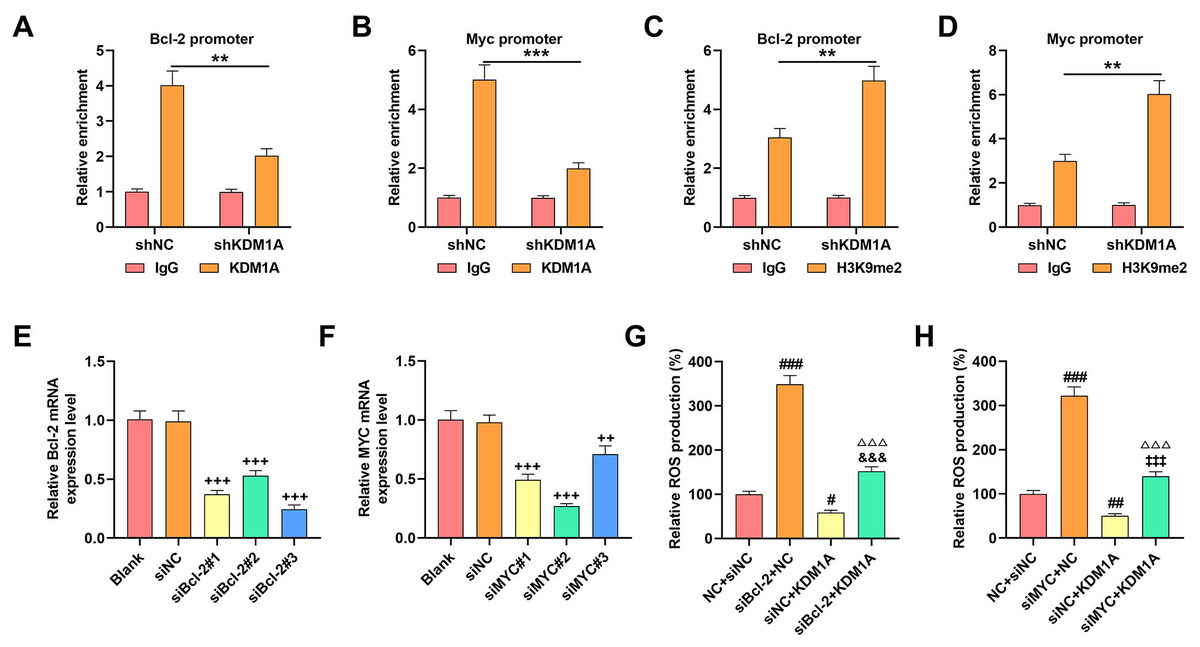Current issue
Archive
Manuscripts accepted
About the Journal
Editorial office
Editorial board
Section Editors
Abstracting and indexing
Subscription
Contact
Ethical standards and procedures
Most read articles
Instructions for authors
Article Processing Charge (APC)
Regulations of paying article processing charge (APC)
ONCOLOGY / RESEARCH PAPER
KDM1A represses the apoptosis in osteosarcoma cells via demethylating Bcl-2/c-Myc
1
Xixi Hospital of Hangzhou, China
2
The Second Affiliated Hospital, Zhejiang University School of Medicine, China
Submission date: 2023-03-17
Final revision date: 2023-07-17
Acceptance date: 2023-07-22
Online publication date: 2023-08-07
KEYWORDS
endoplasmic reticulum stressreactive oxygen speciesosteosarcomademethylationapoptosislysine demethylase 1ABcl-2/c-Myc
TOPICS
ABSTRACT
Introduction:
Background: Considering the poorly understood mechanism of lysine demethylase 1A (KDM1A) in osteosarcoma (OS), we here commence our investigation to fill the blank.
Material and methods:
Methods: Following the transfection as appropriate, 3-[4,5-dimethylthiazol-2-yl]-2,5 diphenyl tetrazolium bromide (MTT) and flow cytometry assays were used to determine the viability and apoptosis of OS cells MG-63, in which the generation of reactive oxygen species (ROS) and the binding between KDM1A and Bcl-2/ cellular Myc (c-Myc) were separately confirmed via DCF-DA method and chromatin immunoprecipitation-PCR. Reverse-transcription quantitative PCR and western blot were finally introduced to quantify the levels of KDM1A/Bcl-2/c-Myc and endoplasmic reticulum (ER) stress-related factors.
Results:
Results: Overexpressed KDM1A enhanced the viability (48 hours) yet repressed the apoptosis and ROS generation, with the downregulation on ER stress-related factors (C/EBP homologous protein [CHOP]; proline-rich extensin-like receptor kinase (PERK) and activating transcription factor 4 [ATF4]) yet the elevation of Bcl-2/c-Myc, while its depletion exerted contrary effects. More importantly, KDM1A could act as the demethylase of Bcl-2/c-Myc, as reflected by the results that the depletion of KDM1A decreased the enrichment of Bcl-2/c-Myc promoter using the antibody against KDM1A yet increased the enrichment by the antibody targeting H3K9me2. Bcl-2/c-Myc silencing, conversely, promoted the ROS generation and apoptosis, elevated the levels of ER stress-related factors and abolished the effects of KDM1A on OS cells.
Conclusions:
Conclusion: KDM1A exerts a repressive effect on the apoptosis of OS cells MG-63 by inhibiting the ROS generation and ER stress via demethylation of Bcl-2 and c-Myc.
Background: Considering the poorly understood mechanism of lysine demethylase 1A (KDM1A) in osteosarcoma (OS), we here commence our investigation to fill the blank.
Material and methods:
Methods: Following the transfection as appropriate, 3-[4,5-dimethylthiazol-2-yl]-2,5 diphenyl tetrazolium bromide (MTT) and flow cytometry assays were used to determine the viability and apoptosis of OS cells MG-63, in which the generation of reactive oxygen species (ROS) and the binding between KDM1A and Bcl-2/ cellular Myc (c-Myc) were separately confirmed via DCF-DA method and chromatin immunoprecipitation-PCR. Reverse-transcription quantitative PCR and western blot were finally introduced to quantify the levels of KDM1A/Bcl-2/c-Myc and endoplasmic reticulum (ER) stress-related factors.
Results:
Results: Overexpressed KDM1A enhanced the viability (48 hours) yet repressed the apoptosis and ROS generation, with the downregulation on ER stress-related factors (C/EBP homologous protein [CHOP]; proline-rich extensin-like receptor kinase (PERK) and activating transcription factor 4 [ATF4]) yet the elevation of Bcl-2/c-Myc, while its depletion exerted contrary effects. More importantly, KDM1A could act as the demethylase of Bcl-2/c-Myc, as reflected by the results that the depletion of KDM1A decreased the enrichment of Bcl-2/c-Myc promoter using the antibody against KDM1A yet increased the enrichment by the antibody targeting H3K9me2. Bcl-2/c-Myc silencing, conversely, promoted the ROS generation and apoptosis, elevated the levels of ER stress-related factors and abolished the effects of KDM1A on OS cells.
Conclusions:
Conclusion: KDM1A exerts a repressive effect on the apoptosis of OS cells MG-63 by inhibiting the ROS generation and ER stress via demethylation of Bcl-2 and c-Myc.
Share
RELATED ARTICLE
We process personal data collected when visiting the website. The function of obtaining information about users and their behavior is carried out by voluntarily entered information in forms and saving cookies in end devices. Data, including cookies, are used to provide services, improve the user experience and to analyze the traffic in accordance with the Privacy policy. Data are also collected and processed by Google Analytics tool (more).
You can change cookies settings in your browser. Restricted use of cookies in the browser configuration may affect some functionalities of the website.
You can change cookies settings in your browser. Restricted use of cookies in the browser configuration may affect some functionalities of the website.



